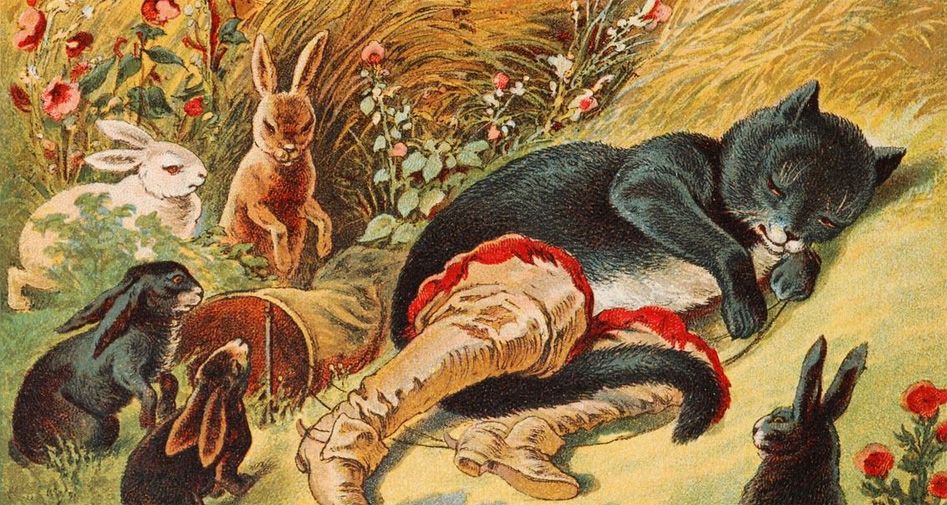Reading time for children: 13 min
A certain miller had three sons, and when he died the sole worldly goods which he bequeathed to them were his mill, his ass, and his cat. This little legacy was very quickly divided up, and you may be quite sure that neither notary nor attorney were called in to help, for they would speedily have grabbed it all for themselves. The eldest son took the mill, and the second son took the ass.
Consequently all that remained for the youngest son was the cat, and he was not a little disappointed at receiving such a miserable portion. „My brothers,“ said he, „will be able to get a decent living by joining forces, but for my part, as soon as I have eaten my cat and made a muff out of his skin, I am bound to die of hunger.“ These remarks were overheard by Puss, who pretended not to have been listening, and said very soberly and seriously:
„There is not the least need for you to worry, Master. All you have to do is to give me a pouch, and get a pair of boots made for me so that I can walk in the woods. You will find then that your share is not so bad after all.“ Now this cat had often shown himself capable of performing cunning tricks. When catching rats and mice, for example, he would hide himself amongst the meal and hang downwards by the feet as though he were dead.
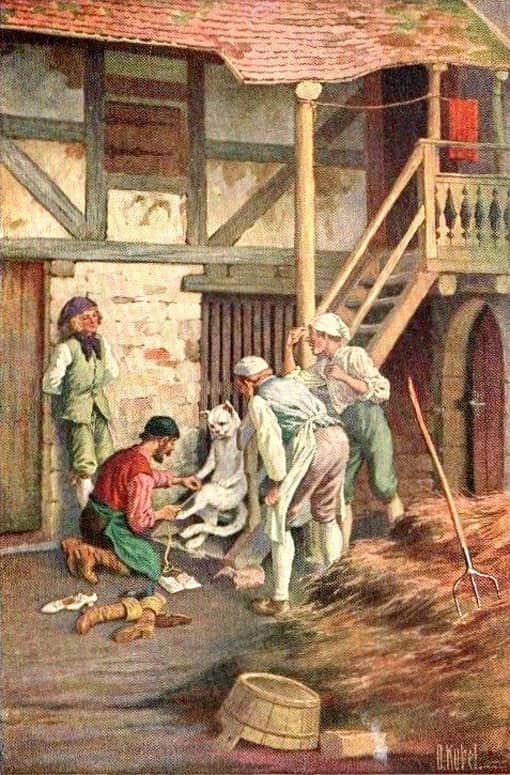 Image: Otto Kubel (1868 – 1951)
Image: Otto Kubel (1868 – 1951)His master, therefore, though he did not build too much on what the cat had said, felt some hope of being assisted in his miserable plight. On receiving the boots which he had asked for, Puss gaily pulled them on. Then he hung the pouch round his neck, and holding the cords which tied it in front of him with his paws, he sallied forth to a warren where rabbits abounded. Placing some bran and lettuce in the pouch, he stretched himself out and lay as if dead.
His plan was to wait until some young rabbit, unlearned in worldly wisdom, should come and rummage in the pouch for the eatables which he had placed there. Hardly had he laid himself down when things fell out as he wished. A stupid young rabbit went into the pouch, and Master Puss, pulling the cords tight, killed him on the instant. Well satisfied with his capture, Puss departed to the king“s palace. There he demanded an audience, and was ushered upstairs. He entered the royal apartment, and bowed profoundly to the king.
„I bring you, Sire,“ said he, „a rabbit from the warren of the marquis of Carabas (such was the title he invented for his master), which I am bidden to present to you on his behalf.“ – „Tell your master,“ replied the king, „that I thank him, and am pleased by his attention.“ Another time the cat hid himself in a wheatfield, keeping the mouth of his bag wide open. Two partridges ventured in, and by pulling the cords tight he captured both of them. Off he went and presented them to the king, just as he had done with the rabbit from the warren.
His Majesty was not less gratified by the brace of partridges, and handed the cat a present for himself. For two or three months Puss went on in this way, every now and again taking to the king, as a present from his master, some game which he had caught. There came a day when he learned that the king intended to take his daughter, who was the most beautiful princess in the world, for an excursion along the river bank.
„If you will do as I tell you,“ said Puss to his master, „your fortune is made. You have only to go and bathe in the river at the spot which 1 shall point out to you. Leave the rest to me.“ The marquis of Carabas had no idea what plan was afoot, but did as the cat had directed. While he was bathing the king drew near, and Puss at once began to cry out at the top of his voice: „Help! help! the marquis of Carabas is drowning!“ At these shouts the king put his head out of the carriage window.
He recognised the cat who had so often brought him game, and bade his escort go speedily to the help of the marquis of Carabas. While they were pulling the poor marquis out of the river, Puss approached the carriage and explained to the king that while his master was bathing robbers had come and taken away his clothes, though he had cried „Stop, thief!“ at the top of his voice. As a matter of fact, the rascal had hidden them under a big stone. The king at once commanded the keepers of his wardrobe to go and select a suit of his finest clothes for the marquis of Carabas.
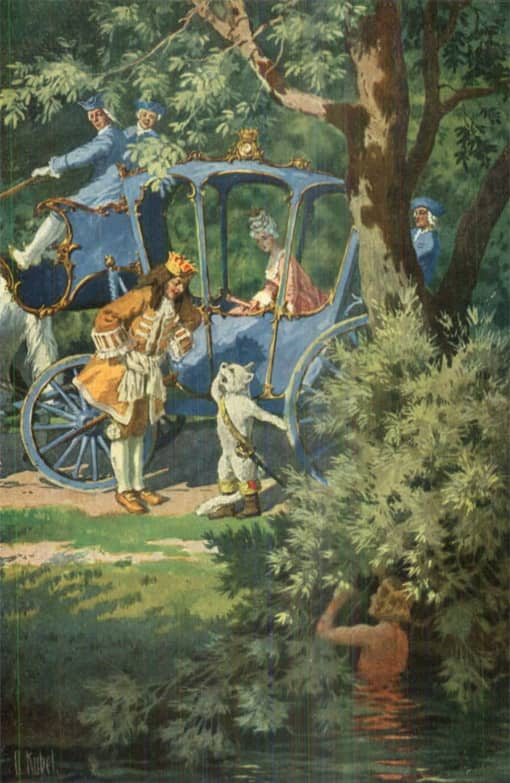 Image: Otto Kubel (1868 – 1951)
Image: Otto Kubel (1868 – 1951)The king received the marquis with many compliments, and as the fine clothes which the latter had just put on set off his good looks (for he was handsome and comely in appearance), the king“s daughter found him very much to her liking. Indeed, the marquis of Carabas had not bestowed more than two or three respectful but sentimental glances upon her when she fell madly in love with him. The king invited him to enter the coach and join the party.
Delighted to see his plan so successfully launched, the cat went on ahead, and presently came upon some peasants who were mowing a field. „Listen, my good fellows,“ said he. „If you do not tell the king that the field which you are mowing belongs to the marquis of Carabas, you will all be chopped up into little pieces like mince-meat.“
In due course the king asked the mowers to whom the field on which they were at work belonged. „It is the property of the marquis of Carabas,“ they all cried with one voice, for the threat from Puss had frightened them. „You have inherited a fine estate,“ the king remarked to Carabas. „As you see for yourself, Sire,“ replied the marquis. „This is a meadow which never fails to yield an abundant crop each year.“ Still travelling ahead, the cat came upon some harvesters.
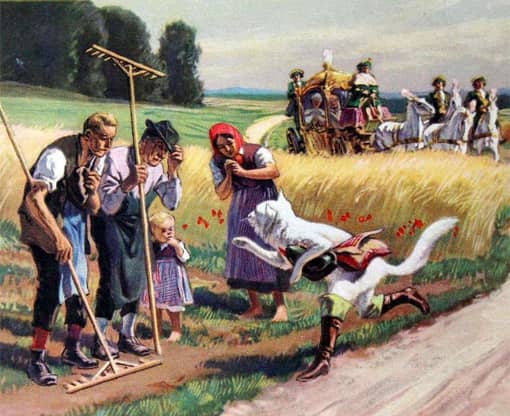
„Listen, my good fellows,“ said he. „If you do not declare that every one of these fields belongs to the marquis of Carabas, you will all be chopped up into little bits like mince-meat.“ The king came by a moment later, and wished to know who was the owner of the fields in sight. „It is the marquis of Carabas,“ cried the harvesters. At this the king was more pleased than ever with the marquis. Preceding the coach on its journey, the cat made the same threat to all whom he met, and the king grew astonished at the great wealth of the marquis of Carabas.
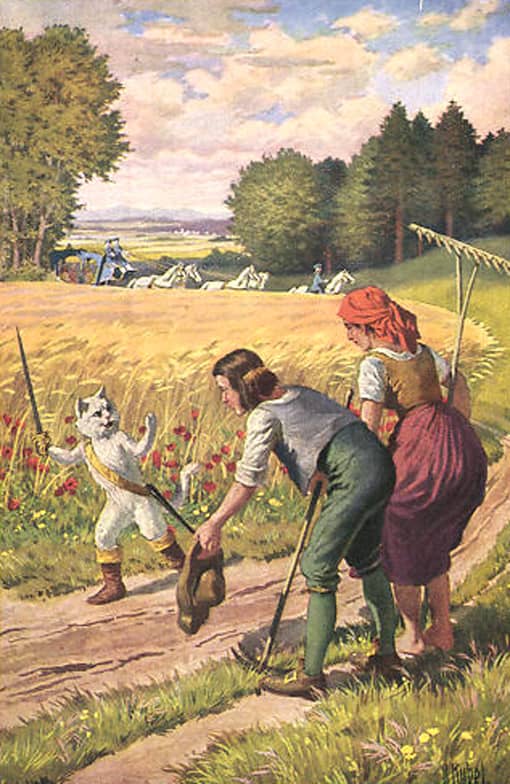 Image: Otto Kubel (1868 – 1951)
Image: Otto Kubel (1868 – 1951)Finally Master Puss reached a splendid castle, which belonged to an ogre. He was the richest ogre that had ever been known, for all the lands through which the king had passed were part of the castle domain. The cat had taken care to find out who this ogre was, and what powers he possessed.
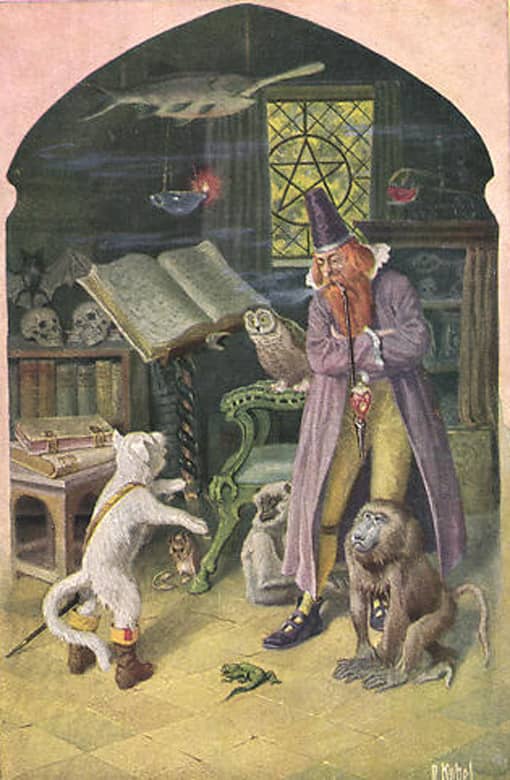 Image: Otto Kubel (1868 – 1951)
Image: Otto Kubel (1868 – 1951)He now asked for an interview, declaring that he was unwilling to pass so close to the castle without having the honour of paying his respects to the owner. The ogre received him as civilly as an ogre can, and bade him sit down. „I have been told,“ said Puss, „that you have the power to change yourself into any kind of animal—for example, that you can transform yourself into a lion or an elephant.“
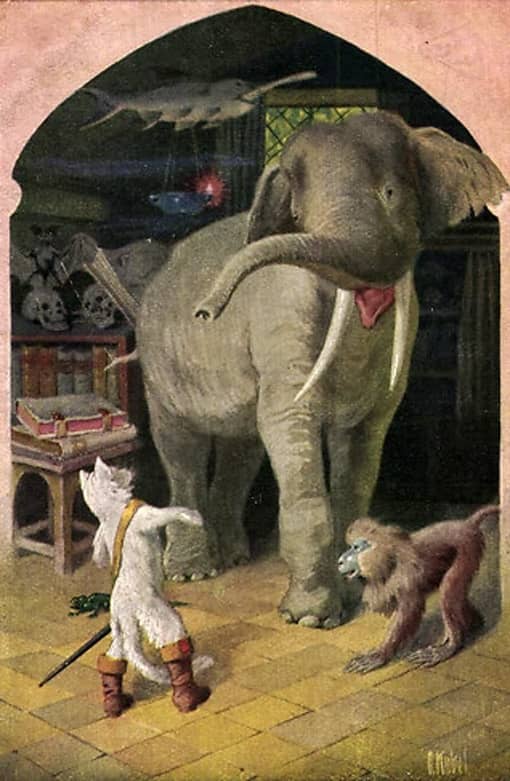 Image: Otto Kubel (1868 – 1951)
Image: Otto Kubel (1868 – 1951)„That is perfectly true,“ said the ogre, curtly. „And just to prove it you shall see me turn into a lion.“ Puss was so frightened on seeing a lion before him that he sprang on to the roof—not without difficulty and danger, for his boots were not meant for walking on the tiles. Perceiving presently that the ogre had abandoned his transformation, Puss descended, and owned to having been thoroughly frightened.
„I have also been told,“ he added, „but I can scarcely believe it, that you have the further power to take the shape of the smallest animals—for example, that you can change yourself into a rat or a mouse. I confess that to me it seems quite impossible.“ – „Impossible?“ cried the ogre. „You shall see!“ And in the same moment he changed himself into a mouse, which began to run about the floor. No sooner did Puss see it than he pounced on it and ate it.
Presently the king came along, and noticing the ogre“s beautiful mansion desired to visit it. The cat heard the rumble of the coach as it crossed the castle drawbridge, and running out to the courtyard cried to the king: „Welcome, your Majesty, to the castle of the marquis of Carabas!“ – „What“s that?“ cried the king. „Is this castle also yours, marquis? Nothing could be finer than this courtyard and the buildings which I see all about. With your permission we will go inside and look round.“
The marquis gave his hand to the young princess, and followed the king as he led the way up the staircase. Entering a great hall they found there a magnificent collation. This had been prepared by the ogre for some friends who were to pay him a visit that very day. The latter had not dared to enter when they learned that the king was there. The king was now quite as charmed with the excellent qualities of the marquis of Carabas as his daughter. The latter was completely captivated by him.
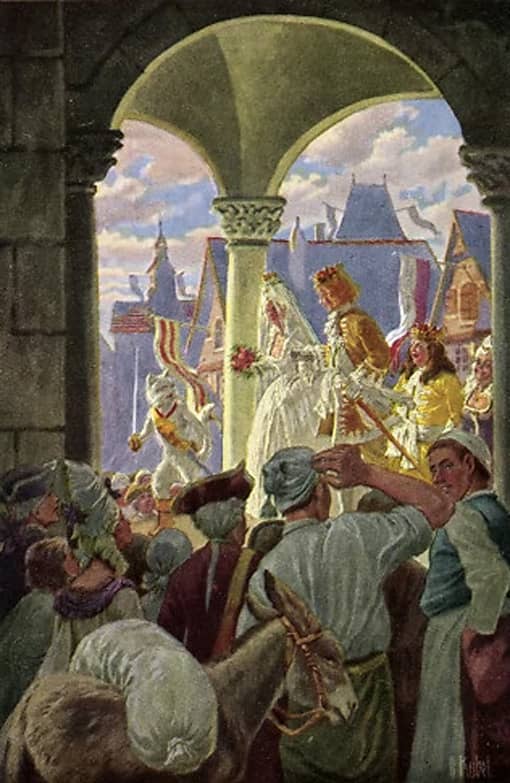 Image: Otto Kubel (1868 – 1951)
Image: Otto Kubel (1868 – 1951)Noting the great wealth of which the marquis was evidently possessed, and having quaffed several cups of wine, he turned to his host, saying: „It rests with you, marquis, whether you will be my son-in-law.“ The marquis, bowing very low, accepted the honour which the king bestowed upon him. The very same day he married the princess. Puss became a personage of great importance, and gave up hunting mice, except for amusement.
 Learn languages. Double-tap on a word.Learn languages in context with Childstories.org and Deepl.com.
Learn languages. Double-tap on a word.Learn languages in context with Childstories.org and Deepl.com.Backgrounds to fairy tale „Puss in Boots“
„Puss in Boots“ is a popular European fairy tale that has been adapted and retold by many authors and folklorists throughout history. The version most well-known today was written by Charles Perrault in 1697, not the Brothers Grimm. The Brothers Grimm did include a similar tale called „The Master Cat“ or „The Cat in the Boots“ in their collection of fairy tales, but it’s important to note that Perrault’s version is the most famous one.
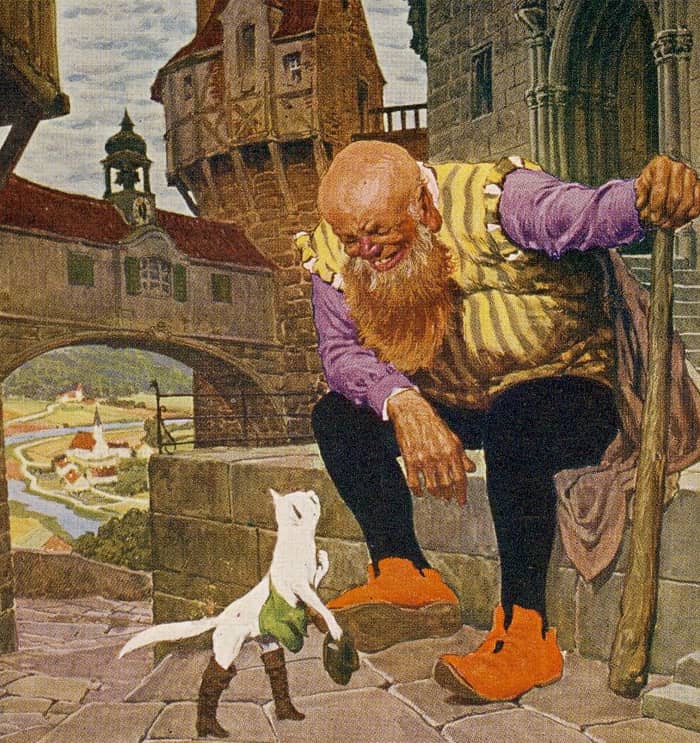
The origins of the „Puss in Boots“ story can be traced back to various folktales and literary works from different cultures. Here are a few backgrounds of the fairy tale:
Ancient India: One of the earliest known versions of a tale similar to „Puss in Boots“ can be found in the „Panchatantra,“ an ancient Indian collection of animal fables that dates back to the 3rd century BCE. In a story called „The Loss of Friends,“ a clever cat serves his master by outsmarting a group of animals and gaining wealth for him.
Italian literature: Giovanni Francesco Straparola’s „The Facetious Nights of Straparola,“ published in the 16th century, includes a story called „Costantino Fortunato.“ In this tale, a cat helps its impoverished master become wealthy and marry a princess by tricking an ogre.
The oral tradition in Europe: The story of „Puss in Boots“ was passed down through oral tradition in Europe, with numerous variations emerging over time. It is believed that Charles Perrault, a French author, heard the story from these oral traditions and adapted it into his own version, which then became the most popular and enduring.
Charles Perrault’s version of „Puss in Boots“ was published in his book „Histoires ou contes du temps passé, avec des moralités“ (Stories or Tales from Times Past, with Morals), also known as „Mother Goose Tales.“ In this version, the cat is a witty and cunning character who helps his master, a poor miller’s son, acquire wealth, power, and a royal bride by using its intelligence and trickery. The story has since become a classic and has been retold and adapted in numerous forms, including books, films, and stage productions.
The tale centers around a cunning and resourceful cat who uses his intelligence and trickery to help his impoverished master rise in social status, ultimately marrying a princess and becoming a wealthy nobleman. The story has been adapted and retold in various forms throughout the centuries, including plays, operas, films, and television shows. The popularity of „Puss in Boots“ can be attributed to its engaging narrative, its memorable protagonist, and the universal themes it explores, such as resourcefulness, social mobility, and the power of perception. The tale continues to captivate audiences and is considered one of the most beloved and enduring fairy tales in Western literature.
Although the Brothers Grimm did include a similar tale in their collection, it’s crucial to recognize that Charles Perrault’s version of „Puss in Boots“ is the most famous and influential version of the story.
Interpretations to fairy tale „Puss in Boots“
While the Brothers Grimm did include a version of the „Puss in Boots“ story in their collection, it is important to note that the most famous version of the story is from Charles Perrault. However, interpretations of the tale can apply to both versions, as they share many similarities. Here are some interpretations of the „Puss in Boots“ story:
Social mobility: „Puss in Boots“ demonstrates that even those born into poverty or difficult circumstances can rise to wealth and power through wit, cunning, and resourcefulness. The cat helps its master, a poor miller’s son, improve his social standing and ultimately marry a princess. This theme of social mobility resonated with audiences in the 17th century, as it provided hope for a better life. The story explores the concept of social mobility, as the youngest son, initially left with nothing but a cat, eventually rises to marry the princess and become a powerful figure. This theme highlights the possibility of change and the power of determination in overcoming social barriers.
The power of cleverness and intelligence: The cat in the story embodies wit, cunning, and intelligence, traits that enable it to outsmart the characters it encounters. The tale celebrates the power of using one’s intellect to overcome obstacles and achieve success. One of the central themes of the story is the importance of being resourceful and clever. The cat demonstrates his intelligence and cunning throughout the tale, using his wits to transform his master’s life. The story suggests that intelligence, creativity, and quick thinking can overcome unfavorable circumstances and lead to success.
The Power of Perception and Deception: The tale shows how perception and deception can be used to one’s advantage. The cat creates a false image of his master as a wealthy and powerful nobleman, convincing the king, the princess, and the commoners. This manipulation of perception eventually leads to the Marquis of Carabas marrying the princess and gaining wealth and status.
Loyalty and Gratitude: The cat’s unwavering loyalty and dedication to his master play a significant role in the story. The cat works tirelessly to improve his master’s life, and in return, his master trusts and follows the cat’s advice. This theme underscores the importance of loyalty and gratitude in relationships and the benefits that can come from mutual support and cooperation.
The importance of appearances: The story of „Puss in Boots“ emphasizes the significance of appearances in society. The cat carefully crafts a new identity for its master, transforming him into the „Marquis of Carabas“ to win the favor of the king and his daughter. This highlights the idea that social standing and success often depend on how one is perceived by others. „Puss in Boots“ highlights the significance of appearance in society. The cat uses the Marquis’s appearance, through fine clothes and a grand castle, to convince others of his wealth and status. This theme serves as a reminder that appearances can be deceiving and that people often judge others based on their outward appearance rather than their true character.
The role of a loyal helper: The cat in „Puss in Boots“ serves as a faithful and devoted helper to its master. It demonstrates loyalty, determination, and perseverance, working tirelessly to secure a better future for the poor miller’s son. This aspect of the story celebrates the value of loyal friends and allies in achieving success.
The trickster archetype: In many folktales and myths, there is a character known as the trickster who uses cunning and deceit to achieve their goals. The cat in „Puss in Boots“ fits this archetype, using its cleverness and resourcefulness to outwit others and secure a better life for its master.
In summary, the story of „Puss in Boots“ can be interpreted in various ways, but some common themes include social mobility, the power of cleverness and intelligence, the importance of appearances, the role of a loyal helper, and the trickster archetype. These interpretations can apply to both Charles Perrault’s and the Brothers Grimm’s versions of the story, as they share many core elements.
Adaptions of the fairy tale „Puss in Boots“
„Puss in Boots,“ also known as „The Master Cat“ or „Le Maître Chat“ in French, is a classic European fairy tale. The story was first recorded by Giovanni Francesco Straparola in his Italian collection „The Facetious Nights“ in the 16th century. Later, Charles Perrault included it in his book „Histoires ou Contes du Temps Passé“ (Stories or Tales of Olden Times), published in 1697. The version by the Brothers Grimm, known as „Der gestiefelte Kater,“ is based on Perrault’s story but with some modifications. Although the Brothers Grimm version of „Puss in Boots“ is less well-known than Charles Perrault’s version, the story itself has inspired numerous adaptations across various forms of media. Here are some specific examples of adaptations that have drawn inspiration from the tale:
Operas and ballets: The story of „Puss in Boots“ has been adapted into several operas and ballets, including the opera „Der gestiefelte Kater“ by César Cui (1915) and the ballet „Le Chat botté“ by Marius Petipa and Cesare Pugni (1868).
Films: The character of Puss in Boots has appeared in various films, most notably as a supporting character in the animated „Shrek“ film series (starting with „Shrek 2“ in 2004). Voiced by Antonio Banderas, this version of the character is a swashbuckling, charming, and humorous cat who aids Shrek and his friends on their adventures. Puss in Boots later received his own spin-off film, „Puss in Boots“ (2011), which serves as a prequel to the „Shrek“ films and tells the story of the character before he met Shrek. „Puss in Boots“ (1932): This animated short film by Walt Disney Productions is a retelling of the fairy tale with a musical score and lively animation. The film was nominated for an Academy Award for Best Animated Short Film. „The True Story of Puss ’n Boots“ (2009): This animated film from France tells the story of a young boy named Jacques who is given a pair of magical boots by a kind old man. Jacques meets a talking cat who helps him win the heart of a princess and defeat an evil ogre. The film features colorful animation and a comedic tone. „Puss in Boots“ (2011): This computer-animated film from DreamWorks Animation stars the popular character of Puss in Boots from the „Shrek“ franchise. The film follows Puss as he teams up with a fellow cat and a notorious thief to steal the famed Goose that lays golden eggs. The film features the voice talents of Antonio Banderas, Salma Hayek, and Zach Galifianakis. „The Master Cat or Puss in Boots“ (1969): This animated film from the Soviet Union is a faithful adaptation of the Brothers Grimm version of the fairy tale. The film features beautiful hand-drawn animation and a traditional storytelling style.
Television series: In 2015, DreamWorks Animation released a Netflix original series called „The Adventures of Puss in Boots,“ which follows the character’s exploits in the hidden city of San Lorenzo. The series ran for six seasons and further developed the character’s backstory and adventures.
Books and comics: The story of „Puss in Boots“ has been retold and adapted in numerous books and comics, ranging from children’s picture books to graphic novels. Some examples include „Puss in Boots“ by Jerry Pinkney (2012), a beautifully illustrated retelling of the classic tale, and „Fables“ by Bill Willingham (2002-2015), a comic book series that features Puss in Boots as one of the many fairy tale characters living in a modern-day world.
Theater: There have been various stage adaptations of „Puss in Boots,“ including plays, musicals, and pantomimes. For example, „Puss in Boots: The Panto“ is a popular British pantomime that humorously retells the story with song, dance, and slapstick comedy.
Games: „Puss in Boots: The Last Wish“ (2013): This video game from Russia is a reimagining of the fairy tale as an adventure game. Players control Puss as he travels through a magical world filled with dangerous creatures and challenging puzzles.
While the Brothers Grimm version of „Puss in Boots“ is not as famous as Charles Perrault’s, the story itself has had a lasting impact on popular culture. These adaptations demonstrate the enduring appeal of the tale and its characters, showing that the themes and motifs present in the story continue to resonate with audiences today. These are just a few examples of the many adaptations of „Puss in Boots“ that have been created over the years. The enduring popularity of the story is a testament to its timeless themes and memorable characters.
Summary of the plot
The Brothers Grimm version of „Puss in Boots“ is quite similar to Charles Perrault’s more famous version, but some minor differences may exist between the two. In summary, the plot of the Brothers Grimm’s „Puss in Boots“ is as follows: A miller dies and leaves his three sons his possessions: the mill, a donkey, and a cat. The youngest son inherits the cat and laments his bad luck, thinking the cat is useless. However, the cat assures the young man that he can help him improve his fortune if he is given a pair of boots.
The young man provides the cat with boots, and the cat sets off on a series of clever schemes to secure his master’s future. The cat catches rabbits and birds, presenting them as gifts from his master, whom he calls the „Marquis of Carabas,“ to the king. One day, the cat learns that the king and his daughter will be taking a ride along the river. The cat convinces his master to undress and jump into the water as if he were bathing, while the cat hides his clothes. When the king’s carriage approaches, the cat claims that his master’s clothes have been stolen. The king sends his servants to fetch fine clothes for the „Marquis of Carabas.“
Meanwhile, the cat races ahead and tricks the inhabitants of the land, which is owned by a cruel ogre, into saying that the land belongs to the Marquis of Carabas when the king asks. The cat then visits the ogre’s castle and uses his wit to trick the ogre into transforming into a small animal, which the cat promptly kills. When the king arrives at the castle, the cat presents it as the home of the Marquis of Carabas. The king is impressed by the young man’s apparent wealth and grants his daughter’s hand in marriage to him. The young man and the princess marry, and they live happily ever after, with the clever cat by their side. In summary, the Brothers Grimm’s „Puss in Boots“ tells the story of a clever and resourceful cat who uses his intelligence and cunning to secure a prosperous future for his master, helping him rise from poverty to marry a princess and become a marquis.
Abstract
„Puss in Boots“ by Brothers Grimm tells the story of a miller who leaves his three sons an inheritance of a mill, an ass, and a cat. The youngest son, who receives the cat, is initially disappointed. However, the cat, who is quite clever, assures his master that he will be able to help him. The cat asks for a pair of boots and a pouch, then sets out to hunt and bring gifts to the king on behalf of his master, whom he calls the Marquis of Carabas.
One day, the cat learns that the king and his beautiful daughter will be traveling by the river. He instructs his master to bathe in the river, while the cat hides his clothes and cries for help, claiming that the Marquis of Carabas is drowning. The king sends his guards to save the young man and provides him with fine clothes. The princess becomes smitten with the Marquis, and the king invites him to join them on their journey.
The cat goes ahead of the royal party, threatening peasants to claim the land they work on as the property of the Marquis of Carabas. The king is impressed by the vastness of the Marquis’s supposed lands. Eventually, the cat reaches a splendid castle inhabited by a wealthy ogre. The cat tricks the ogre into turning into a mouse and then eats him. When the king arrives at the castle, the cat claims it belongs to the Marquis of Carabas. The king, impressed by the Marquis’s wealth and character, offers his daughter’s hand in marriage, which the Marquis accepts. The cat becomes a person of great importance and lives a life of leisure, only hunting mice for amusement.
Informations for scientific analysis
Fairy tale statistics | Value |
|---|---|
| Number | KHM 33a |
| Aarne-Thompson-Uther-Index | ATU 545B |
| Translations | DE, EN, EL |
| Readability Index by Björnsson | 33.9 |
| Flesch-Reading-Ease Index | 75.7 |
| Flesch–Kincaid Grade-Level | 7.2 |
| Gunning Fog Index | 9.8 |
| Coleman–Liau Index | 8.7 |
| SMOG Index | 9.9 |
| Automated Readability Index | 7.3 |
| Character Count | 9.208 |
| Letter Count | 7.115 |
| Sentence Count | 94 |
| Word Count | 1.709 |
| Average Words per Sentence | 18,18 |
| Words with more than 6 letters | 269 |
| Percentage of long words | 15.7% |
| Number of Syllables | 2.277 |
| Average Syllables per Word | 1,33 |
| Words with three Syllables | 125 |
| Percentage Words with three Syllables | 7.3% |
